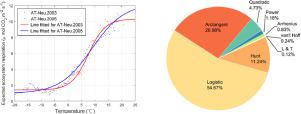Agricultural and Forest Meteorology ( IF 6.2 ) Pub Date : 2021-08-05 , DOI: 10.1016/j.agrformet.2021.108576 Zhiyuan Zhang 1 , Huanyuan Zhang 2 , Zikun Cui 3 , Feng Tao 4 , Ziwei Chen 3, 5 , Yaxuan Chang 1 , Vincenzo Magliulo 6 , Georg Wohlfahrt 7 , Dongsheng Zhao 5

|
Many studies have been carried out to quantify the trend of terrestrial ecosystem respiration (Re) in a warming world, but a conclusive answer has not yet been confirmed because the temperature sensitivity of Re was found inconsistent under different scales or regarding different types of respiratory flux. Aiming at reconciling the relationship between temperature and Re across different scales (i.e., short-term and site-to-site), we proposed a method to reduce noises of half-hourly Re measurements and applied nine empirical models to a 1387 site-year FLUXNET datasets. Regarding the temperature sensitivity of half-hourly Re records, we found a surprisingly consistent result that the sigmoid functions outcompeted other statistical models in 82% of site-year combinations, and on average, achieved a staggering R2 value of 0.92, indicating the positive correlation between Re and temperature on fine time scale (within one site-year dataset). Even though Re of all biomes followed sigmoid functions, the parameters of the S-curve varied strongly across sites or years. This explains why measured Q10 value (an index denote temperature sensitivity) largely depends on observation season and site. Furthermore, on the interannual variation of Re, we did not find any relationship between mean annual temperature (MAT) and mean annual Re within any site, which implies that the small year-to-year variation of the sigmoid pattern is large enough to counteract the warming effect on Re. This study brings up a conceptual framework to integrate the relationship between temperature and Re under short-term or site-to-site scales. It also provided evidence to support the argument that the relationship between MAT and mean annual Re by using data across multiple sites should not be used to interpret the response of respiration under global warming.
中文翻译:

陆地生态系统呼吸对温度响应的全球一致性
已经进行了许多研究来量化变暖世界中陆地生态系统呼吸(Re)的趋势,但尚未得到确凿的答案,因为在不同尺度或不同类型的呼吸通量下发现Re的温度敏感性不一致. 为了协调不同尺度(即短期和站点到站点)温度与Re之间的关系,我们提出了一种降低半小时Re测量噪声的方法,并将九个经验模型应用于 1387个站点-年 FLUXNET 数据集。关于半小时Re的温度敏感性记录,我们发现了一个令人惊讶的一致结果,即 sigmoid 函数在 82% 的站点年组合中胜过其他统计模型,并且平均实现了惊人的R 2值 0.92,表明Re与温度在精细时间尺度上呈正相关(在一个站点年数据集中)。尽管所有生物群落的Re都遵循 sigmoid 函数,但S曲线的参数在不同地点或年份之间变化很大。这解释了为什么测量的Q 10值(表示温度敏感性的指数)在很大程度上取决于观测季节和地点。此外,关于Re的年际变化,我们没有发现任何站点内的年平均温度 (MAT) 和年平均Re之间有任何关系,这意味着 S 型模式的逐年小变化足以抵消对Re的变暖效应。本研究提出了一个概念框架,以在短期或站点到站点尺度下整合温度与Re之间的关系。它还提供了支持以下论点的证据,即通过使用跨多个站点的数据,MAT 与年平均Re之间的关系不应用于解释全球变暖下呼吸的响应。



























 京公网安备 11010802027423号
京公网安备 11010802027423号